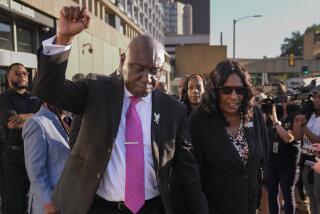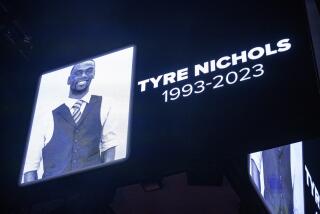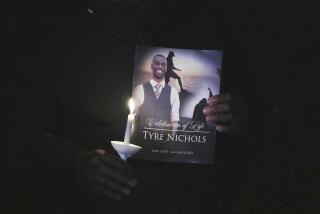Nichols Wanted Out, Witness Says
DENVER — A month before the bombing of the Oklahoma City federal building, Terry L. Nichols wanted out of the conspiracy and Timothy J. McVeigh desperately sought out others to help him carry out the plot, the government’s chief witness testified Thursday.
“Tim told me that Terry no longer wanted to help him mix the bomb,” Michael Fortier said in his second day on the witness stand in Nichols’ capital murder trial. “He told me that there was some problem between--or the problem had to do with Terry’s wife, Marife.
“I asked Tim what he was going to do if Terry didn’t help him,” Fortier said of his former friends. “I made a joke and said: ‘What would you do? Would you kill him if he doesn’t help you?’
“And he answered me seriously and said he would not do that and he went on to say that Terry would have to help him because he’s in it so far up till now.”
Fortier’s testimony could help with Nichols’ defense by indicating that he was a reluctant participant, although it is equally clear that--if Nichols wanted out of a conspiracy--he must have been an active participant in it.
On cross-examination, Michael Tigar, the chief defense attorney, fashioned much of his questioning around the premise that Fortier, and not Nichols, was deep into the conspiracy.
Tigar noted that Fortier had accompanied McVeigh on a driving trip through Oklahoma City, where they looked over the Alfred P. Murrah Federal Building as well as the spot where McVeigh would leave his getaway car. Together, both men fenced stolen guns to raise money the government said was needed to finance the bombing, he pointed out. And Fortier helped store blasting caps and other explosive materials that McVeigh had given him for safekeeping, he said.
Fortier also was the government’s chief witness in McVeigh’s trial earlier this year, in which McVeigh was convicted and sentenced to death. McVeigh, Nichols and Fortier were Army friends in the late 1980s and all three later expressed anger at the government for the FBI’s deadly assault that killed more than 80 people in 1993 in a religious compound near Waco, Texas.
But only McVeigh and Nichols were charged in the April 19, 1995, bombing, which killed 168 people. Fortier was arrested on four other federal charges, including transporting the stolen firearms and lying to the FBI about the bombing. He pleaded guilty. In return for his cooperation, he is hoping that prosecutors will ask for leniency when he is sentenced.
*
Fortier, 28, testified Thursday that he and McVeigh had a falling out in March 1995 when he refused McVeigh’s entreaties to take Nichols’ place as the No. 2 man in the scheme. He said McVeigh raised the subject while the two men were taking a walk in the desert near Fortier’s home in Kingman, Ariz.
“He said we could be a couple of desperadoes,” Fortier said. “I said no and Tim became upset. And when Tim becomes upset, he becomes very quiet. We went into my house and Tim went into a front bedroom and he stayed there the rest of the night.”
On cross-examination, Tigar tried repeatedly to place Fortier closer to the bombing, even contrasting the behavior of the two after the explosion. Nichols, he said, surrendered and talked to the FBI while Fortier mounted a campaign of lies.
Removing his glasses and leaning directly toward Fortier, Tigar asked in a mocked tone: “You didn’t conspire with Timothy McVeigh to blow up that building, did you?”
Fortier pushed back his shoulders, paused and answered: “No sir, I did not.”
Tigar asked Fortier if he was in central Kansas in the days before the bombing, where chemicals for the bomb were mixed and placed inside a rented Ryder truck. Fortier said that he was not.
The attorney asked if Fortier was in Oklahoma City the morning of the blast. Fortier said he had stayed up all night at home smoking crystal methamphetamine and playing video games.
And Tigar suggested to Fortier that he has lied to the FBI to save himself from the death penalty, which Nichols faces if convicted.
“That scared you, didn’t it?” Tigar asked.
“It certainly concerned me,” Fortier said.
“It scared you, didn’t it?” Tigar repeated.
“Yes,” Fortier said.
In Kingman, Fortier was an admitted drug user who often railed against the federal government. He usually dressed in T-shirts and sported a black beard and he wore his hair long. His language often was laced with profanities.
On the witness stand Thursday, he wore a conservative gray suit and maroon tie. His hair was combed and the beard was gone.
As he did in the first trial, he described McVeigh as a paranoid anti-government enthusiast who drifted across the country buying and selling guns and planning to avenge the Waco tragedy with the Murrah building explosion.
But he said he saw Nichols only occasionally--when Nichols might be passing through Kingman--in the months before the bombing. He said McVeigh often bragged about his plans with Nichols.
“He said they had chosen a building in Oklahoma City,” Fortier testified. “He said they had chosen that building because that’s the building the orders for Waco came out of. He said they were going to detonate it on the anniversary of Waco.”
Furthermore, he said, McVeigh dismissed the innocent victims as nothing more than “storm troopers from Star Wars in the Evil Empire.”
Fortier said McVeigh also told him that he and Nichols stole blasting caps and other explosives from a Kansas rock quarry.
He said McVeigh told him that Nichols had stolen firearms from an Arkansas horse farmer and gun dealer and that one of the weapons, a .50-caliber cannon-like rifle with a broken firing pin, later was repaired at the Nichols family farm in Michigan.
Fortier said that, when he had problems selling the guns, Nichols was angry.
Nevertheless, Fortier said, he was stunned that McVeigh’s bomb scheme was carried out. “I thought his plans with Mr. Nichols were never going to happen.”
More to Read
Sign up for Essential California
The most important California stories and recommendations in your inbox every morning.
You may occasionally receive promotional content from the Los Angeles Times.











